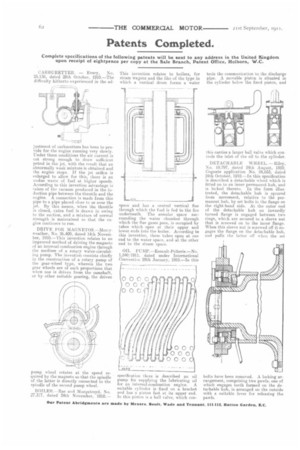Patents Completed.
Page 22

If you've noticed an error in this article please click here to report it so we can fix it.
Complete specifications of the following patents will be sent to any address in the United Kingdom upon receipt of eightpence per copy at the Sale Branch, Patent Office, Holborn, W.C.
CARBURETTER. — Every, No 25,138, dated 28th October, 1910.—The difficulty hitherto experienced in the ad
justment of carburetters has been to provide for the engine running very slowly. Under these conditions the air current is not strong enough to draw sufficient petrol in the jet, with the result that an abnormally weak mixture is obtained and the engine stops. If the jet orifice is enlarged to allow for this, there is an undue waste of fuel at. higher speeds. According to this invention advantage is taken of the vacuum produced in the induction pipe between the throttle and the engine. A connection is made from this pipe to a pipe placed close to or over the jet. By this means, when the throttle is closed, extra fuel is drawn in owing to the suction, and a mixture of normal strength is maintained so that the engine continues to run.
DRIVE FOR MAGNETOS.—Men yweather, No. 26,409, dated 14th November, 1910.—This invention relates to an improved method of driving the magneto of an internal-combustion engine through the medium of a rotary water-circulating pump. The invention consists chiefly in the construction of a rotary pump of the gear-wheel type, wherein the two gear wheels-are of such proportions that when one is driven from the camshaft, or by other suitable gearing, the driven pump wheel rotates at the speed required by the magneto so that the spindle • of the latter is directly connected to the spindle of the second pump wheel.
BOILER.—Rae and Murgatroyd, No. 27.317, dated 24th November, 1910.- This invention relates to boilers, for steam wagons and the like of the type in which a vertical drum forms a water space and has a central vertical flue through which the fuel is fed to the fire underneath. The annular space surrounding the water chamber through which the flue gases pass, is occupied by tubes which open at their upper and lower ends into the boiler. According te this invention, these tubes open at one end to the water space, and at the other end to the steam space.
OIL P131P.--Esnault-Pelterie.—No. 1,540;1911. dated under International Convention 28th January, 1910.—In this specification there is described an oil pump for supplying the lubricating oil for an internal-combustion engine. A suitable cylinder is fixed on a bracket and has a piston fast at its upper end. In this piston is a ball valve, which con trols the communication to the discharge pipe. A movable piston is situated in the cylinder below the fixed platen, and this carries a larger ball valve which controls the inlet of the oil to the cylinder.
DETACHABLE WHEEL. —Riley, No. 19,797, dated 24th August, 1910. Cognate application No. 24,653, dated 24th October, 1910.—In this specification is described a detachable wheel which is fitted on to an inner permanent hub, and is locked thereto. In the form illustrated, the detachable hub is spured from movement, relative to the permanent hub, by set bolts in the flange on the right-hand side. At the outer end of the detachable hub an inwardly turned flange is engaged between two rings, which are secured to a sleeve nut that is screwed on to the inner flange. When this sleeve nut is screwed off it engages the flange on the detachable hub. and pulls the latter off when the set
bolts have been removed. A locking ar rangement, comprising two pawls, one of which engages teeth formed on the de texhable hub, is arranged on the outside with a suitable lever for releasing the pawls.






















